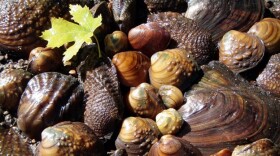If you did not participate or have not heard, the first weekend in May was opening fishing in Wisconsin. That meant I enjoyed time with friends and family in the Northwoods with my line in the water. In Wisconsin, opening fishing applies to certain species of fish such as walleye, trout, largemouth bass, and northern pike. However, this season opener does not apply to panfish, which are open year-round. Panfish include species such as bluegill, crappie, sunfish, and yellow perch. Let’s talk about one of these panfish, the crappie, a great tasting fish that will be coming into the shallows to spawn in the coming days.
Wisconsin has two types of crappies – the black crappie and the white crappie. Black crappies are generally darker than white crappies. Both species have black spots, but the black crappie has many more in a mottled pattern on the back and sides. White crappies tend to be paler and have spots arranged in loose, narrow bands running down their sides. Black crappies have a more northern range and are more common in Wisconsin. White crappies have a more southern range and are more abundant in the southern United States. In southern Wisconsin, both species can be found in the same body of water. The black crappie is well distributed throughout the state, except in the streams of the driftless area of southwestern Wisconsin.
Crappies fall into the general panfish category because they are small fish (rarely larger than a foot long in Wisconsin) sought primarily for food. Still, crappies do provide anglers considerable sport. While crappies are not known as great fighters at the end of the line, catching crappies takes a certain finesse because they have a very thin membrane around their mouths.
Many an angler has lost a good-sized "papermouth" by using too much force setting the hook.
Crappies like open water but they also like structure, such as submerged stumps and logs, rocks and rocky ledges, deep pools in rivers, and emergent aquatic vegetation if it is not too dense.
Crappies feed on small aquatic organisms called zooplankton, and aquatic insects and insect larvae that live on or near such structures. Crappies have numerous gill rakers (comb-like structures within the gills) that enable them to filter large amounts of food from water. These small food items make up almost all of the diet of small crappies and can make up a major portion of larger crappies' diets during parts of the year. However, older crappies feed primarily on small fish like minnows and immature bass, sunfish and perch.
Crappie spawning activity peaks in May and June when water temperatures are between 61 and 68 degrees, though spawning may continue into July. Like other panfish, crappies are nest builders, but they are perhaps the least particular in their nest-building habits. Crappies search out nest spots in deeper water than any other sunfish - between 1.5 to 6 feet deep or deeper. Crappies usually nest in colonies that may include as many as 35 nests, 3 inches to 6 feet apart. Males construct disc-shaped nests near emergent vegetation using their caudal fins like brooms to sweep away silt and debris. Unlike bluegills and pumpkinseeds that are meticulous in their nest construction, crappies spend little time building their nests, which when finished, may be just barely discernible from the surrounding area.
Males aggressively defend their nests, chasing and biting at intruders. A female may be chased away several times before the male will admit her for spawning. When a pair does spawn, they swim in circles around the nest until they come to rest with their bellies touching and pushing against each other. Both fish quiver as the female releases her eggs and the male releases his milt (sperm). This process is usually repeated several times over several hours. Females may spawn with more than one male and may produce eggs several times during the spawning period. An individual female produces several thousand to several hundred thousand eggs depending upon her age and size. Following spawning, males guard the eggs until they hatch in one to two days at optimum temperatures of 65 to 70 degrees. Crappie fry (newly hatched fish) congregate in large schools in shallow water. Crappies grow rapidly in the first year, reaching 2.5 to 3 inches. Crappies can mature in their second year, though most mature in their third to fourth year. In Wisconsin, most crappies don't live much past their fifth year, grow larger than 12-14 inches, or weigh more than a pound.
I look forward to crappie fishing every spring as it is the doorway to the summer season. In my opinion, fun times and memories fishing with family and friends are priceless and will be cherished for years to come.
Article Adapted from Holtan, P. 1997. Crappies. Wisconsin Department of Natural Resources, Bureau of Fisheries Management and Habitat Protection. PUBL-FH-71297. July 1997.









